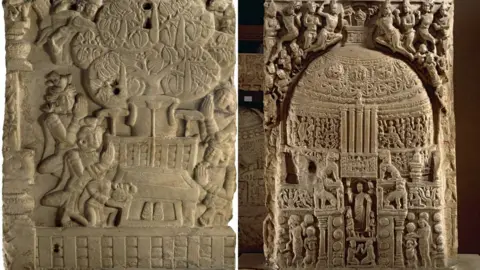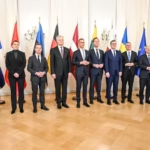Introduction: The British Museum Unveils Ancient India’s Spiritual Art
The British Museum in London presents an extraordinary exhibition titled Ancient India: Living Traditions, showcasing the profound transformation of India spiritual art across centuries. With 189 remarkable artifacts on display, the exhibition offers visitors an unparalleled journey through the sacred iconography of Hinduism, Buddhism, and Jainism.

The Evolution of Indian Religious Art
From 200 BC to AD 600, India witnessed a dramatic shift in how divinity was visually represented. Deities and spiritual leaders evolved from symbolic forms into more anthropomorphic depictions India spiritual art. Curator Dr. Sushma Jansari explains: Today we can’t imagine Hindu, Jain, or Buddhist deities without human form, which is what makes this transition so fascinating.
Early religious art often depicted nature spirits — such as serpents (nagas), elephants, and peafowl — that were worshipped across all three religions. Over time, these symbolic representations evolved into intricate sculptures of gods, goddesses, tirthankaras, and the Buddha himself.
Buddhism: From Symbols to Figurative Art
The exhibition’s Buddhist section features an extraordinary two-sided sandstone panel from a sacred shrine in Amaravati (India’s southeast). One side, carved around AD 250, shows the Buddha in full human form. The other side, from an earlier period (50-1 BC), displays symbolic elements — a tree, footprints, and an empty throne — representing the Buddha’s presence without portraying his physical form India spiritual art.

This panel is a rare artifact highlighting the transition from symbolic to figurative Buddhist art, making it a centerpiece of the exhibition. As BBC coverage reports, it’s “quite extraordinary” to witness such transformation encapsulated in a single object India spiritual art.
Hinduism: The Rise of Divine Goddesses

Hindu art’s evolution is beautifully represented through an early bronze figure resembling both a yakshi (nature spirit) and a Hindu goddess. This figure, dating from AD 1-100, combines nature worship with the emerging features of Hindu deities — multiple arms, symbolic objects, and elaborate headdresses, foreshadowing the iconography of goddesses like Gajalakshmi.
The blending of yakshi imagery into goddess forms marks a pivotal moment in Hindu visual tradition. This fusion of nature and divinity reflects the dynamic growth of sacred art in ancient India.
Jainism: Enlightened Teachers in Stone
The Jain section offers striking sculptures of the 24 enlightened teachers known as tirthankaras. A standout piece is a sandstone carving from AD 200-300, showing a tirthankara with a halo and the sacred symbol of an endless knot on the chest. This piece exemplifies the Jain focus on spiritual purity and the visual consistency of their religious art over centuries.
Common Roots and Shared Workshops
Interestingly, many sculptures across these religions were commissioned from the same workshops in Mathura, resulting in notable stylistic similarities. As reported on World News Today, this interconnected craftsmanship underscores India’s rich tradition of artistic collaboration across spiritual lines.
The Multi-Sensory Experience at the British Museum
The exhibition goes beyond visual art, offering visitors a multi-sensory experience with vibrant colors, drapes, incense scents, and nature sounds. Videos of contemporary practitioners in Britain highlight that these ancient traditions remain alive, thriving among global communities even today.

The Global Legacy of Indian Spiritual Art
By the 3rd century BC, Buddhist missionaries carried Indian spiritual art beyond its borders to China, Cambodia, and other parts of Asia. The exhibition showcases exquisite examples like a silk watercolour painting of the Buddha from AD 701-750, underscoring the global reach of India’s sacred art.
Conclusion: Celebrating India’s Living Spiritual Heritage
Unlike most South Asian exhibits that focus on a single faith, Ancient India: Living Traditions is unique for presenting the simultaneous evolution of Hindu, Buddhist, and Jain art. This collective approach highlights not only their distinctiveness but also their shared roots.
Dr. Jansari notes that while the exact reasons for the shift to anthropomorphic depictions remain debated, one thing is clear: The flourishing of figurative art reveals a collective human desire to visualize divinity in relatable forms.
The exhibition runs at the British Museum from 22 May to 19 October, offering an unmissable window into India’s timeless spiritual artistry that continues to captivate audiences worldwide.









